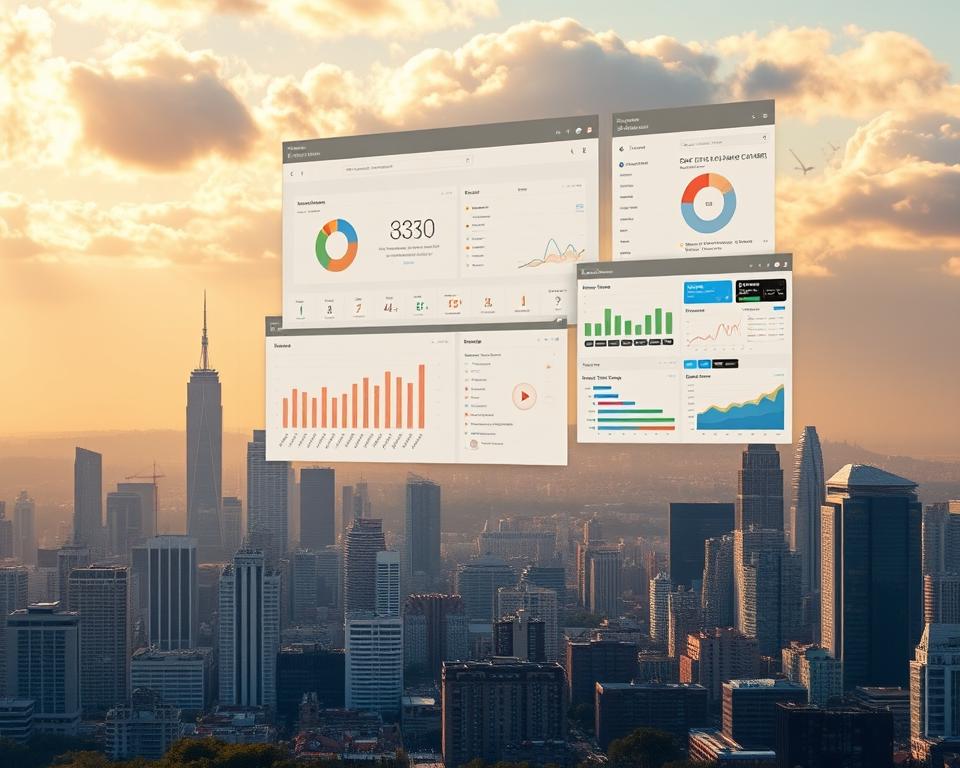Marketing1on1: Local SEO Specialists – Boost Your Venture
Were you aware 78% of handheld users visit a business in just one day following its discovery via regional search outcomes? Such is the might of mastering neighborhood searches—exactly that which Marketing1on1 enables enterprises to attain.
Marketing1on1 represents a highly acclaimed firm focused on enhancing prominence on Google Search and Maps. Their strategies ensure that companies emerge when consumers look for nearby services. Armed with 20+ years in the field, they’ve helped hundreds of clients grow through tailored solutions – SEO company near me
Google gives precedence to community-centric results, particularly for searches including “near me”. Marketing1on1’s expertise ensures your business stands out, attracting in-person visits and digital engagements. Their proven methods include optimizing Google My Business, managing directories, and tracking performance metrics.
Major Highlights
- 78% of handheld searches result in physical visits in less than 24 hours.
- Marketing1on1 specializes in improving search rankings for businesses.
- Google favors localized results for service-based queries.
- 28% of area-specific searches culminate in instant transactions.
- Their dashboard integrates with major platforms for seamless management.
Defining Local SEO and Its Significance
92% of buyers choose enterprises from the premier page—how does yours fare? Focused optimization confirms that your outlet, practice, or bistro surfaces when nearby users look. In contrast to conventional methods, it zeroes in on closeness, Google Business Profiles, and community directories.

Understanding Hyper-Focused Optimization
This method isolates urban or area-specific prominence. Such as, a bridal shop in Charlotte achieved a 130% increase in traffic by refining for area-specific searches. Key differences from broader tactics:
- Proximity: Google emphasizes establishments in immediate vicinity.
- Listings: Steady citations on Yelp or Yellow Pages establish credibility.
- Testimonials: 81% of buyers consult reviews prior to visiting.
How Local Searches Affect Your Income
Dining establishments employing these tactics doubled their in-person visits. For what reason? 800 million monthly “near me” queries across the U.S. open limitless possibilities. Google evaluates companies using:
- Suitability: The degree to which your offerings align with the query.
- Closeness: Physical location from the searcher.
- Visibility: Web standing and external link endorsements.
Voice search enhances this effect—71% prefer natural-language queries like “best pizza near me.” Adjusting to these trends maintains your advantage.
The Inner Workings of Local SEO: Essential Mechanisms
Google’s system emphasizes three pivotal factors for local queries. These ranking components—suitability, proximity, and eminence—dictate entry into the prized map segment. Perfect these, and your enterprise emerges as the leading selection for nearby clients.
Clarifying Google’s Community Ranking Elements
Here’s how Google weighs its decisions: 55% pertinence, 30% nearness, and 15% eminence. Relevance means matching user queries with your services. A confectionery fine-tuning for “gluten-free cupcakes” secures a superior position for that query.
Proximity matters too. In cases where two companies deliver alike services, the one in closer vicinity usually triumphs. Prominence hinges on reputation—think reviews, citations, and website authority. A top-rated Google Business Profile featuring over 100 reviews surpasses the competition.
Differences Between Local and Traditional SEO
Hyper-targeted optimization focuses on map visibility and NAP (Name, Address, Phone) consistency. Traditional methods prioritize backlinks and broad keywords. For instance, OHSO Brewery increased visits by 130% through individual profile optimization per location.
- Customized Outcomes: The localized cluster refreshes within a one-mile span.
- Mobile-First: 72% of mobile users frequent locations within 5 miles.
- Instruments: Resources like Local Falcon trace rankings at the block level.
The Power of Google Business Profile for Local Rankings
A complete Google Business Profile can boost visits by 70%—are you maximizing yours? Profiles with accurate details see 50% higher purchase consideration. This complimentary resource acts as your virtual storefront for nearby clients.
Configuring Your Profile to Maximize Exposure
Start with verification. Google confirms your business’s address via mail or phone. Skipping this procedure renders your profile invisible in searches. Fill every field:
- Types: Primary + secondary selections influence 43% of rankings. Decide prudently.
- Photos: 10+ high-quality images lift conversions by 35%. Highlight merchandise, personnel, and interiors.
- Operating Times: Correct timings avert dissatisfied customers and ranking losses.
Refining All Components to Improve Performance
Regular updates keep your profile competitive. Schedule posts with tools like Semrush Social to highlight promotions. Reflect competitor service terms to boost relevance.
Elements like “outdoor seating” or “free Wi-Fi” sort your company for specific searches. Connect your profile to geo-targeted landing pages—not the main homepage—for improved conversion rates.
Reply to reviews in under 48 hours. Interaction cues enhance your profile’s weight in Google’s system. An exemplary profile boasting 100+ reviews surpasses inactive rivals.
Mastering Local Keyword Research
Identifying the proper keywords can determine your digital presence. For enterprises focusing on nearby audiences, keywords like near me or in [city] generate 46% of queries. Resources like SEMrush and Google Keyword Planner expose these intent-rich phrases.
Resources for Unearthing High-Intent Community Keywords
Initiate with competitor research. The SEMrush Keyword Gap tool reveals gaps in your strategy. For example, an HVAC company found 24-hour AC repair Phoenix converted 3x better than generic terms.
Yelp Suggest mines hidden queries like open now Mexican restaurants downtown. Geo-grid tools like Local Falcon pinpoint underperforming areas. Voice search adaptation is crucial too—71% of users request services in a conversational manner.
Comparing Long-Tail and Short-Tail Terms for Local SEO
Long-tail phrases (4+ words) make up 62% of searches. They’re specific, like best gluten-free bakery Brooklyn. Short-tail terms (bakery near me) cast a wider net but attract less qualified traffic.
Prioritize modifiers: in [city] signals planning, while near me indicates urgency. A coffee establishment focusing on best latte Williamsburg achieved a 35% rise in traffic by optimizing its keyword blend.
NAP Listings: Establishing Credibility Through Uniformity
Uniform online business information fosters reliability—akin to a well-maintained shopfront. Your business name, phone number, and address (NAP) must match across every platform. Minor mismatches disorient customers and impair rankings.
Premier Directories for Local Company Entries
Start with essential platforms: Google Business Profile, Apple Maps, and Yelp. Specialized directories (e.g., ZocDoc for health services) provide focused visibility. A plumbing business achieved a 40% conversion uplift by rectifying its directory entries.
Aggregators like Data Axle spread your NAP data to smaller sites. Maintain precision to prevent extensive mistakes. Insider tip: Work with your local Chamber of Commerce to obtain high-quality backlinks.
Identifying and Repairing Citation Inconsistencies
Utilize SEMrush Listing Management for spotting discrepancies. Unify repeated listings—e.g., two Yelp profiles for one venue. Comply with these NAP standards:
- Literal match: “Ave” compared to “Avenue” disrupts uniformity.
- Style: (555) 123-4567 vs. 5551234567 perplex search algorithms.
- Modifications: Modifying your phone number should prompt simultaneous edits across listings.
Establish a standard guide for franchises to keep details uniform. Resources such as BrightLocal monitor fixes in real time.
On-Site SEO Techniques for Community Enterprises
Eager to gain more nearby patrons? Refining your site’s internal components can transform outcomes. Enterprises possessing geo-targeted pages enjoy a 78% ranking boost—demonstrating that minor adjustments lead to major outcomes.
Crafting High-Impact Title Tags and Meta Descriptions
Your title tag functions as a virtual shop sign. Follow this pattern: “Service in City . For instance, “Emergency Plumbing in Austin .
Meta descriptions should include geo-modifiers. “Best organic café in Portland” performs better than generic phrases. Keep both under 60 characters to avoid truncation.
Creating High-Converting Local Landing Pages
Dedicated pages for each service area boost relevance. Incorporate maps, personnel profiles, and reviews from nearby customers. A roofing company tripled leads by adding neighborhood-specific case studies.
Use LocalBusiness schema markup with geo-coordinates to help search engines display your address and hours directly in results.
- Interlinked location strategy: Tie each local page back to a main services page.
- Mobile-first design: 53% of searches abandon non-mobile-friendly sites.
- Fresh content: Update neighborhood guides seasonally.
The Role of Online Reviews in Local SEO
93% of users examine reviews before deciding on a business—where do you stand? Feedback shapes trust, and search engines reward profiles with fresh, detailed testimonials. In fact, sentiment impacts 17% of your visibility in results.
Simple Ways to Encourage Happy Customers to Share Feedback
Facilitate hassle-free review sharing. Use QR code table markers at checkout or dispatch SMS review links after service. Marketing1on1’s monitored approaches enhance feedback rates by 40%.
- Train staff: A swift inquiry following a transaction drives more feedback.
- Exploit social networks: Instagram Story features directly link to review portals.
- Prompt timing is key: Request feedback within 24 hours of service.
Handling Negative Reviews Like a Pro
Just one grievance might dissuade 30 prospective clients. Address quickly by following the AAA technique: Acknowledge, Apologize, Act. Shift contentious exchanges offline by suggesting “Let’s resolve this—email us”.
Tools like Semrush alert you to new feedback. One dental practice experienced a 25% boost in appointments by publicly resolving issues.
Insider tip: Showcase top reviews on service pages. Social proof stacks credibility and nudges visitors to contribute their own.
Link Building for Local Domination
Backlinks account for almost 30% of your exposure—are you acquiring the optimal ones? Quality backlinks indicate trustworthiness to search algorithms, elevating your company above competitors. This is how to obtain them in a strategic manner.
Local Sponsorships and Community Backlinks
Back a Little League squad or community 5K charity event. Such collaborations typically feature backlinks on event pages. One HVAC firm secured 42 credible backlinks through a food bank collaboration—demonstrating that kindness yields rewards.
Focus on directories such as Chamber of Commerce listings. Such directories commonly provide dofollow link opportunities. Pro tip: Create press kits for media outreach, making it easy for journalists to feature your business.
Recapturing Lost Backlinks and Unlinked References
Utilize Ahrefs Content Explorer to locate references to your company missing hyperlinks. Reach out politely: “Thanks for featuring us! Could you link to our site?” A bakery recovered 15+ links this way.
HARO (Help a Reporter Out) allows proprietors to establish expertise. Provide responses enriched with local perspectives. A plumber secured a Forbes backlink by offering localized advice.
- Repairing Broken Links: Locate broken links from competitor partnerships. Suggest your link as a substitute.
- Data Markup: Add LocalBusiness tags to help search engines connect mentions to your profile.
- Online Discussion Platforms: Participate in regional forums (such as Nextdoor) offering helpful commentary—profiles typically carry links.
Local Optimization for Businesses with Multiple Locations
Expanding to multiple locations? Your website needs a tailored approach for each area. Conventional methods fall short—Google appreciates businesses that tailor their online footprint for each location.
Overseeing Unique Profiles per Area
Establish separate Google Business Profiles for each business venue. OHSO Brewery experienced a 130% increase in visits by refining each site’s profile separately. Critical actions:
- Distinct landing pages: Highlight personnel profiles, local happenings, and neighborhood visuals.
- Consolidated oversight: Utilize centralized tools like Google Business Profile Manager to revise hours or menus for all locations concurrently.
- Inventory tags: Showcase location-tailored products (e.g., “Available at our Phoenix branch”).
Avoiding Duplicate Content Pitfalls
Repeating service descriptions negatively affect SEO. Rather, employ urban-specific content sections. A spa chain grew organic traffic by 140% by adding neighborhood guides to each page.
For similar pages, use canonical tags or noindex meta directives. Illustratively, “Plumbing Services in Phoenix” and “Plumbing Services in Tempe” need distinctions beyond the city title.
Voice Search and Its Impact on Local SEO
The evolution of voice search is reshaping how users discover businesses—are you set? With 71% of users preferring spoken queries, optimizing for natural language is no longer optional. Phrases such as “open now” surged by 400% with voice assistants like Alexa transforming search behavior.
Tuning for “Near Me” Searches and Natural Queries
Verbal queries comprise complete questions instead of isolated keywords. Rather than saying “best pizza,” users inquire “Who has the best gluten-free pizza near me?” Customize your content to respond to these queries:
- Common Queries Sections: Respond to “what’s” and “where’s” inquiries using brief answers.
- Schema markup: Use SpeakableSchema to help devices read your answers aloud.
- Top Answer Spot: Target the zero position—voice devices extract information from here.
A pizza outlet in New York increased voice-based orders by 65% with FAQ schema integration. Their “delivery radius” area addressed the primary voice search question.
Pro Tips for Voice Search Domination
Control your Google Knowledge Panel. Confirm your company information for consistency on all devices. Optimize for Alexa and Echo by claiming your Yelp profile—these platforms prioritize it for local results.
Mobile matters too. 25% of voice searches happen on phones. Guarantee that your site loads rapidly and includes easy-to-find contact buttons.
Tracking Your Local SEO Performance
Are you measuring what truly matters for your business visibility? Regular monitoring ensures your efforts drive real results. Concentrate on indicators that show how users locate and engage with your enterprise.
Vital Measurements to Keep an Eye On
Begin by examining your map pack rank. Being among the first three results increases click-through rates by 60%. Keep an eye on “near me” rankings—as they generate quick visits.
The pace of receiving reviews is also important. Profiles with 5+ new monthly reviews grow faster. Utilize Google Search Console to analyze city-specific metrics. It indicates where your strengths and weaknesses lie.
Instruments for Live Position Monitoring
SEMrush Position Tracking details performance on a ZIP code basis. Match it against Local Falcon’s heatmaps for precise block-by-block data. One retail outlet enhanced its CTR by 33% with this technique.
Label your Google Profile clicks using UTM tags. This reveals which listings convert best. Always track at least three competitors—their moves affect your rankings.
Regular reports need to be transparent and operational. Underline ranking patterns and link them to conversion metrics. Refine your approach according to the insights gained.
Expert Local Optimization Advice from Marketing1on1
Marketing1on1’s proven strategies take business visibility to the next level. Statistics reveal that sites with schema enhancements receive 30% additional clicks—demonstrating that technical adjustments yield genuine outcomes. These next-level strategies extend past elementary tweaks to rule search rankings throughout the year.
Leveraging Schema Markup for Local Listings
Structured data helps search engines understand your business details. LocalBusiness structured data encompasses pricing, geographic coordinates, and operating times. One landscaper leveraging schema overtook competitors in “spring cleanup” queries via rich snippets.
Resources such as Google’s Structured Data Markup Helper simplify the process. Concentrate on these components:
- Operational regions: Specify your service radius for mobile queries
- Event structured data: Emphasize events or periodic promotions
- Feedback structured data: Present review stars prominently in listings
Seasonal Approaches to Elevate Visibility
Timing matters—88% of searches for services happen on mobile during peak seasons. Design “Back-to-School” promotions or festive specials with geo-targeted pages. Marketing1on1 advises the following Google Posts composition:
- 40% promotions (limited-time offers)
- 30% neighborhood news (regional event partnerships)
- 30% learning content (timely guidance)
Micro-influencers with hyperlocal followings amplify reach. A bakery partnered with neighborhood food bloggers, increasing foot traffic by 25%. Remember to adjust holiday schedules promptly—dedicated GBP posts avert customer dissatisfaction.
Expert tip: Create a quarterly plan for geo-focused content. Sync website banners with Google Business Profile updates for consistent messaging.
Typical Local Optimization Pitfalls to Prevent
Small errors can cost big when it comes to online visibility. Small inaccuracies—like uneven contact data or a sluggish website—can divert potential customers to the competition. Here’s how to sidestep the top pitfalls.
Mismatched NAP Details on Various Channels
Your business name, address, and phone number (NAP) must match everywhere. A single typo (“Ave” vs. “Avenue”) can trigger a 37% ranking drop. Illustratively, a restaurant saw a 22% reduction in visits after Yelp displayed an old address.
- Combine duplicate profiles (like two Google My Business listings).
- Revise data on aggregators such as Data Axle to fix common mistakes.
- Audit quarterly with Yext to maintain accuracy.
Overlooking Mobile Usability in Local SEO
53% of mobile users bounce if a site loads slowly. Since 76% of nearby search happens on phones, your website needs:
- Responsive design (no pinching to zoom).
- Prominent call buttons in the upper section.
- Compressed images (under 1MB).
Insider note: Test mobile speed with Google’s PageSpeed Insights. A mere 1-second delay can decrease conversion rates by 7%.
Resources to Simplify Your Community SEO
Suitable instruments can convert search visibility challenges into opportunities. Be you a local enterprise or a multi-site operation, an effective toolset conserves time and magnifies outcomes. Consider these guidelines for an informed choice.
Complimentary Tools for Small Enterprises
Start with Google Business Profile. It serves as the cornerstone of your digital footprint. Pair it with:
- Google Keyword Planner: Uncover high-intent phrases like “24-hour plumber near me”.
- AnswerThePublic: Map out voice-based queries (such as “Where’s the nearest ATM?”).
- Google Analytics: Monitor which local areas generate the highest traffic.
These free-of-charge tools provide valuable, actionable data.
Advanced Tools for Large-Scale SEO Campaigns
Extensive brands benefit from resilient solutions. SEMrush Local ($50/month per location) offers rank tracking and listing management. Review premium choices:
- Yext solution: Automatically corrects listings in over 150 directories.
- Uberall platform: A 40-location chain saved 300 hours/month with its centralized dashboard.
- Local Falcon platform: Analyzes rankings at a granular, block-by-block level for focused optimization.
Pro tip: Merge SEMrush keyword statistics with Local Falcon’s geographical reports to gain full visibility. Tools like BrightLocal bridge gaps for mid-sized businesses at $39/month.
Case Studies: Local SEO Success Stories
Real-world results prove the power of targeted strategies—here’s how businesses transformed their visibility. These stories highlight the revenue-boosting potential of smart optimizations.
From Empty Tables to Fully Booked: A Restaurant’s Turnaround
A Mexican dining spot in Austin recorded a 112% boost in traffic post-optimization of its Google Business Profile and menu pages. Primary strategies:
- Included location-specific images of items such as “breakfast tacos near downtown”.
- Responded to 100% of reviews within 4 hours, improving sentiment by 40%.
- Leveraged SEMrush to optimize for “happy hour specials Austin” — achieving a #1 rank in 3 weeks.
Service Providers Dominating Search Results
An HVAC company cracked page one for 38 “emergency repair” keywords. Their playbook:
- Developed geo-targeted landing pages (such as “AC repair in Phoenix”).
- Garnered links from community news outlets through storm readiness advice.
- Executed a “free maintenance check” campaign via Google Posts—resulting in a 30% increase in calls.
Pro tip: Marketing1on1’s law firm client gained 80 leads/month by combining local blog posts with citation cleanups. Brands operating in several locations witnessed 140% organic growth over a six-month period employing these methods.
As a Final Point
Establishing a formidable online profile demands strategy—not rapid fixes. Marketing1on1 supports your business in conquering local searches by enhancing Google Business Profiles, streamlining citations, and utilizing reviews. Such initiatives accumulate over 6–12 months, converting searches into steadfast customers.
92% of nearby searches convert within 48 hours. Avoid quick-fix schemes—consistent tracking and quarterly reviews sustain growth. Initiate immediately: Obtain your free audit via Marketing1on1 and fine-tune your profile for prompt effect.
Pro tip: Regular monthly ranking evaluations and updated content ensure you stay competitive. Grasp the fundamentals, and observe your exposure skyrocket.


